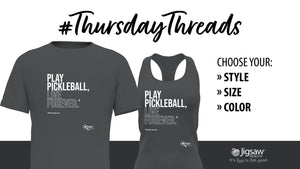Want to get the most out of your workouts? Then you might want to know what types of muscles you are activating.
Thomas DeLauer breaks down the differences between the three types of Muscle Fiber on the latest #ScienceSaturday
Make sure you are meeting the RDI 400mg of Magnesium per day with Jigsaw's MagSRT™ – America's #1 Time-Release Magnesium Supplement.
Click here to add 3 bottles of Jigsaw MagSRT™ to your cart and save $20.94 + $10 off.
Transcript by Rev.com
-What's going on Jigsaw land, it's Thomas DeLauer. When it comes down to making sure that you're recovered and making sure that you're getting the most out of your workouts, it's important that we know what kind of muscles you're actually activating. So in this video, I wanna give you a little bit of a low down on the Type 1, Type 2a, Type 2b muscle fiber types and how you might be training to aid a specific muscle fiber type. So let's get right into it.
-Type 1 is a slow-twitch muscle. What that means is that it has a very low force output but has a lot more in the way of endurance capabilities. So it has the ability to create energy for a long period of time. Now a slow twitch muscle fiber is usually very red in color if you were to look at it with a muscle biopsy test. Simply because it has high amounts of what are called myoglobin but it also has a high amount of blood flow and a high amount of oxygen. You see that slow twitch muscle utilizes the aerobic pathway for energy. It's not using carbs, it's using fats via beta oxidation. What does that mean? It means that those slow twitch muscles, the endurance muscles, use fat as a source of fuel, which means that the fat has to combine with oxygen from the air that we breathe that gets carried in the blood in order to actually create energy.
-Hence, why Type 1 muscle fibers are much more red and have much more blood flow. Because they need the oxygen, they need the blood to actually create energy. Unlike a muscle that requires strictly carbohydrates in a chemical process to create energy. Now because as oxygen reacts in the mitochondria to create energy, we also find that we have high levels of mitochondria in these slow twitch muscle fibers. And if you've done a low carb diet or a ketogenic diet or you've watched some of my videos, then you know mitochondrial efficiency improves when you're in ketosis. Well, it would make sense that when you're on a low carb, high fat diet you have a lot more endurance. You don't fatigue as much because the mitochondria can actually process it a lot easier.
-Okay, so now, let's talk about Type 2 fibers. Because as you start to increase intensity of your workouts, you're gonna start to recruit more of the Type 2 muscle fibers that you have, but we have two different kinds of Type 2. We have Type 2a and Type 2b. Type 2a is sort of the intermediary, okay. It can do partially aerobic and partially anaerobic, which in my opinion is pretty darn cool. It has the ability to flip flop back and forth. It has the ability to provide you with endurance function of the muscle, allowing you to say, run middle distance, like the 800 meter run or the one mile run. But it also has the ability to give you a lot of power. Now, the caveat is it fatigues very fast. So, it's a lot like a Type 1, in that it's a relatively low force output but it can also go really, really high force output. But in both cases, it fatigues pretty fast.
-A good example of when you're using a Type 2a muscle fiber is when you're doing like an 80 to 90% workout or maybe you're doing a crossfit style workout where you're combining endurance with anaerobic but you're not really pushing the envelope like you would be with power lifting. That's where Type 2b comes in. Type 2b is strictly anaerobic. There's very little blood flow and there's not very red in color because it doesn't have amounts of myoglobin and it doesn't get a lot of oxygen. It is strictly anaerobic, which means it's creating energy and creating force from carbohydrates.
-Now, a lot of you watching my channel probably follow a ketogenic or a fasting lifestyle and you're probably wondering, well shoot, can I have strength and power without carbohydrates in this case? And the short answer is, well, you're body's always gonna find carbohydrates. It's always going to make them no matter what. So you always will have a little bit of force output with your Type 2b. So you don't have to worry about that. So that leads me into the next part. Can you shift a muscle fiber into a different kind of muscle fiber, depending on how you're training or how you're eating? Well, yes and no.
-So, there's actually some studies to back this up. In fact, there was a study that was published in the Journal of Strength and Conditioning Research that wanted to look at just this. They wanted to look at the effect of training and how it would change given muscle fiber types. Well, the short answer is what they found is that you can't shift from Type 1 muscle fibers to Type 2 but you can very easily shift from Type 2a to Type 2b depending on the type of training that you're doing. So, what can we conclude from this though?
-Well, depending on how you're eating and what you're doing with your given lifestyle in terms of your workouts, you can dictate how your body's gonna utilize these. If you're not in ketosis, it might be a good time to focus on recruiting a little bit more of the Type 2b. Allowing yourself to become stronger. Allowing yourself to do a little bit more in the way of power movements. But then, when you go into a more ketogenic lifestyle, then you wanna focus more on your Type 2a, meaning doing the intermediary stuff. You don't have to go hardcore just into endurance work, but you can go in to a little bit more 80% workouts where you doing kind of half way between anaerobic work and half way between aerobic work. It's a lot of what I do now.
-So focusing on the higher repetition range but still keeping cardio involved too so you're leveraging the power that you get from a ketogenic lifestyle or a low carb diet but still also keeping that Type 2b portion a little bit alive by still incorporating the strength work. What's interesting, what that study had found you don't ever increase the amount of muscle fibers that you have but you do increase their size. So for example, if we are born with 50% slow twitch and 50% fast twitch, you're never going to be able to make yourself have more fast twitch. But you are going to allow those fast twitch muscles to become bigger. You're not gonna have hyperplasia where you're actually creating more muscle fibers.
-So for example, some people are born with a little bit more of one another. So it depends on what kind of athlete you are. Some very gifted endurance athletes might be born with something more like 70% slow twitch and 30% fast twitch. Doesn't mean that they can convert that extra fast twitch that they have at 30% over to slow twitch or vice versa. They can't take 20% of their slow twitch and make them more fast twitch. But they can shrink or enlarge a given muscle fiber type depending on how they train.
-So, although it's not the answer that you're probably looking for, you can't go from an endurance athlete to being a perfect strength athlete. You can find that middle ground by leveraging the power of a Type 2a muscle fiber, which means train in that zone where you're doing a little bit of both. A little bit of strength training, little bit of endurance work.
-And of course, recovery is the most important thing of all. Whether you're training heavy, whether you're training light or whether you're running a marathon, you wanna make sure that you're getting the minerals that you need, so that's why always an advocate for Jigsaw's Mag SRT and if you click on the link, of course, you can learn more about how that can change your life, change your workouts, but also just make you a healthier person all around. We'll see you soon.























